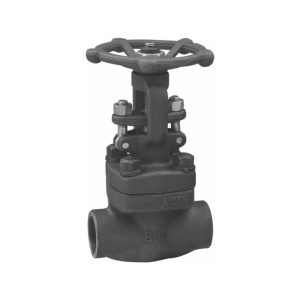Table of Contents
ToggleGate valves that are also known as sluice valves are valves that open by raising a round or rectangular gate out of the fluid’s course. Since the part that either prevents or makes flow through the valve acts as a gate, they’re called that.
What is a Gate Valve?
It is a linear motion valve that controls the flow of fluid in a piping system. The flow is directed to stop or start by a gate or wedge-type disc that moves perpendicular to the flow. The gate valve is the most widely used in any process plant and is suitable for both above-ground and underground installations.
A sluice valve is another name for a gate valve. It is very simple to open; raise the gate out of the way of the fluid. It does not require a large surface and can be fitted into a small space along the pipe axis. To achieve proper sealing, the disc and seat must have a 360° surface contact. A gate valve is made up of many components that allow it to work properly. The valve’s body or shell is the most critical component of the valve since it connects the inlet and outlet pipes in a piping system.
What is the Gate Valve’s theory of operation?
On the top of the gate valve is a handle wheel that, when rotated clockwise, causes the steam and gate to travel downward. It stops fluid from leaking through the valve.
The valve is opened when the wheel is rotated anti-clockwise, and the steam and gate travel upward over the fluid. The gate valve may also be used in a semi-open state, but this will cause the gate to erode as fluid moves through it, so it is not recommended.
How do gate valves work?
Gate valves are often utilized to control flow, but they aren’t always the best option because they’re built to be completely open or closed. When a straight-line fluid flow and minimal flow restriction are needed, they are used. The standard gate valve has no obstacle in the flow path when completely opened, resulting in very low friction loss. Throttling with gate valves is not a smart idea. Because of the valve’s nature, flow control is difficult, and fluid slapping in contradiction of a partly open gate can cause significant damage to the valve. Gate valves should not be used for regulating unless expressly approved.
Gate valves are classified as either rising or non-rising stem valves. Growing stem valves are used when it’s critical to know if the valve is open or closed right away and when fluid pollutants could damage the threads (stem and gate) exposed to the fluid. When the valve is opened, the stem of the valve rises out of the valve. Where vertical space is restricted or underground, non-rising stems are used. The stem of the stem is threaded through the opening. The threads shift the gate upward or downward as the handwheel on the stem is rotated, while the stem remains vertically static. To indicate the gate’s location, this type of valve almost always has a needle indicator threaded onto the upper end of the stem.
The valve body is sealed with bonnets to prevent leaks. The bonnet of a gate valve may be screwed in, unionized, or bolted. The screw-in bonnet is the most basic, providing a long-lasting, pressure-tight seal. Union bonnet is ideal for applications that need to be inspected and cleaned frequently. It also contributes to the body’s power. For larger valves and higher pressure applications, a bolted bonnet is used.
A pressure seal bonnet is another type of bonnet used in gate valves. This design is used for valves subjected to high pressures, usually more than 15 MPa (2250 psi). Compared to other constructions, the pressure seal bonnet’s body-bonnet joint seals strengthen as the valve’s internal pressure rises. In contrast, other constructions appear to leak at the body-bonnet joint as internal pressure rises.
Flanged ends are common on gate valves, and they are drilled to meet pipeline flange dimensional requirements. Cast iron, cast carbon steel, gunmetal, stainless steel, alloy steels, and forged steels are common materials for gate valves.
How do you pick a gate valve?
The valve is a control component in the fluid delivery system, with diversion, shutoff, regulation, throttling, reverse flow, Overflow relief, and other functions to prevent backflow; the valve is a control component in the fluid delivery system, with diversion, shutoff, regulation, throttling, to prevent backflow, the valve is a control component in the fluid delivery system, with diversion, shutoff, regulation, throttling, reverse flow, Overflow relief, and other functions to prevent The pipe’s valve serves as an essential control feature.
The importance of selecting the most appropriate valve linked to pipeline protection, traffic loss, expense, and other factors, necessitates familiarity with the valve’s characteristics and selection of the valve’s steps and basis.
Gate valves, globe valves, check valves, ball valves, butterfly valves, throttle valves, plug valves, diaphragm valves, safety valves, control valves, traps, and special valves are all produced in China today. The maximum working pressure is 600 MPa; the maximum nominal diameter is 5350mm, the maximum working temperature is 1200 °C, the minimum working temperature is -196 °C, the media for water, steam, gasoline, natural gas, heavy corrosive media (such as concentrated nitric acid, concentrated sulfuric acid, etc.), flammable media (such as dumb, ethylene, etc.), poisonous media (such as hydrogen sulfide), et cetera Cast iron, high and low alloy steel, stainless steel acid resistance, Hastelloy alloy, forged steel, Monel alloy, duplex stainless steel, Inquire nickel ore, titanium, and so on. Also, we provide support for the manufacture of various mechanical, pneumatic, and hydraulic valve energy devices.
To choose the most appropriate for the installation of the pipeline system valve products in the face of such a large number of valve varieties and such a range of complex conditions, first, understand the characteristics of the valve; second, the master should choose the steps and basis of the valve; the rules.










